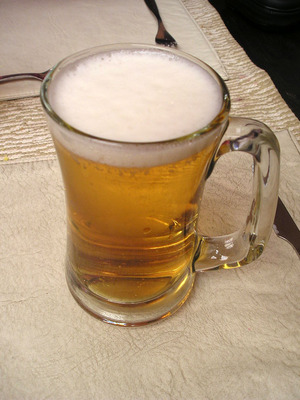Scotch! Ahhhh.
There is something about ordering this drink that makes it seem authoritative, even commanding. It seems to say, I am all business, I know what I want and my palette has evolved above all else. Nothing wrong with beer and other spirits, but at a business power lunch, a scotch drinker seems to get a nod of assurance. If you just want to get smashed there are lots of spirits to get you stumbling drunk but for those special occasions, to close the big deal, to impress the CEOs or maybe just unwind after a hard day of hostile business takeovers; scotch seems to be the drink of choice in the world of doers.
So how do you order? What brand? Single malt or a blend? Isn’t this stuff expensive? If you can’t tell a good whiskey from Uncle Jed’s home hooch, let me help you chose before you go slumming back to your regular swill.
It seems a daunting task but fear not, our staff (me, myself and I) have done the legwork. It was a tough mission, many whiskeys were sampled but, hey, someone had to do it.
Blends? Single Malts…. what’s this? I just want a whiskey bar keep!
If your idea of a good time is to get hammered and do a face plant in the chip dip at the party, there are plenty of libations on the market, to crank you well above the legal limit, so really, why are you reading this? Sure you can get gunned on Scotch but that is not the purpose of this whiskey. It is to be enjoyed and for many different reasons.
There are basically three types of scotch whiskeys with 3 basic taste groups in each category. Lets start with the types of scotch before we go to flavor.
The most common, or what used to be the most common, are blends. These are made by the bigger companies and are a mix of several whiskeys from many silent distilleries. Often a good distillery, of which Scotland has many, are bought up by the big bottlers to ensure they have a steady supply of quality whiskey to mix for their brands. Their experts then select the finest whiskeys from all these sources to blend. The common myth is that blends are often a low end product. Not so. Some blends can get into the high end and can exceed $200.00 a bottle.
Single Malts are whiskeys that come from one distillery only, often some of the finest. Their rise in popularity has caused a price increase, on average, of 600% in the last 5 years!
Single malts always have the year of aging on the bottle. This is the age of the youngest whiskey from the contributing distilleries. There may be more mature ones in the mix but labeling regulations state that only the baby in the bottle be mentioned. The older the combination, the better it usually tastes. Basically a single malt is a blend from under the same roof, using only that distiller’s special stocks.
The last one is the exclusive single barrel vintage. This comes from one cask only. The year of the whiskey will be on the bottle as well as the number of the bottle. These are the most exclusive, often being one of only a few hundred bottles in the world. If you really want to impress someone with your booze collection, this is the one. Be warned, if your job includes wearing a nametag and a paper hat, adding one of these to your liquor cabinet, may giver your wallet a hernia as the prices are usually highest.
Now you know the breakdown of scotch types, lets get to the reason you drink it; flavor. The 3 basic flavor categories to treat your mouth are:
Neutral- best for any first time scotch drinker. It has the least powerful flavor and is least likely to offend. Smooth without any specific after tastes.
Smoky- often a whiskey is transferred to different barrels to produce added flavors. Sherry or bourbon casks can add this extra aroma and body. These can have a smoky or fruity after taste that lingers a bit longer. A bit more heat going down and a variety of taste experiences.
Peaty- The strongest tasting of the whiskeys. This one stays with you for a bit, to savor. Not for everyone or at least not for every occasion. I have heard a few connoisseurs that prefer this one to relax and unwind, perhaps as a personal reward at the end of a hard day. One scotch drinker told me he often takes up to an hour, or more, to sip and enjoy one ounce of this type.
Don’t expect to see Neutral, Smoky, or Peaty on the label. There are countless variations of all three. This is where a bit of education and sampling can help you. We can hear you ask, “What if I like more than one type? Now what?” Fear not, you are on the right track.
Scotch is as individual as the person and the event for which it is being consumed. It can be as specific as the season, the occasion, or your own personal mood at the time. I consulted the head buyer, David Michiels, of Willow Park Liquor stores in Calgary (one of the largest buyers of whiskey in Canada and probably the most extensive scotch selection in the country). He is of the opinion that if someone says they have a favorite, they probably have not tried enough brands. One whiskey does not fit all moods. I would agree. You need to think of what type suits the moment at hand.
The easiest way to find your favorites, without buying enough scotch to make your neighbors think you have a highland band coming over, is to get your butt to a scotch taste-testing event or class.
There are scotch classes?
Oh yes, and unlike algebra, you may want to sit up front, because the whiskey is often free! Consult your local liquor store. The bigger outlets tend to hold these for they have the room and the selection. Willow Park (www.willowpark.net) has room for up to 80 people for sampling and hold many of these classes and taste events in the fall. These are great for experimenting with some of the more expensive ones, prior to dishing out your hard earned dollars for that special bottle. Even a seasoned scotch drinker (you know who you are) can learn a bit from these events.
Rocks, neat, press…how do you take yours?
There are die-hards that swear by having it straight up, or neat as it is called. That may be fine for some but is it the right way? David Michiels of the Willowpark Liquor Store begs to differ. He is on a first name basis with some of the biggest producers in Scotland and goes over there at least twice a year for sampling to make his stock purchase. He also attends all the festivals so he knows his stuff. (Yes there are scotch festivals proving that maybe there really is a heaven!)
“I prefer it with a bit of water (called press) he explains”. Like wine and cognac, the aroma of scotch is part of its allure. To prove his point we sampled two single malts, (at noon…what a great job this is!). First a Glenmorangie from a burgundy cask (average $38.00 a bottle) and Glenfiddich Havana Cask (around $145.00 a bottle) which had spent a few years residing in a rum cask as part of its aging. We had them neat, taking in the scent. Roll it in the glass like you would a fine wine, or cognac and breathe it in, then sip. Both were quite fine with the Glenmorangie being a bit smokier.
We then sampled both with a bit of bottled water added.
I was amazed at the extra fragrance and how much additional, hidden flavor came out with the bottled water, especially on the higher priced whiskey. You may sense the aroma washing over your insides rather than just shoving through, as when you drank it neat. Try it! They were even smoother tasting and I detected a hint of fruitiness from the time spent in the sherry and rum casks.
Note: Never use tap water, as the chlorine, fluoride and other additives municipalities put in, will taint the taste. Use bottled or filtered water and save the tap water for brushing your teeth or wet t-shirt contests. Avoid well water unless it is of the finest quality. I once saw well water that was too alkaline. It turned the drink dark until it resembled cola. The flavor was also changed. In a word…yuck.
Fine spring water will do nicely however.
Note: Glenfiddich Havana Cask is not available in the USA due to the Cuban reference so buy a bottle just to show up your Yankee pal who popped in for a drink.
If neat is the way you prefer it, stick with it but at least give the water taste-test a try. The lads that make this stuff, in Scotland often do a 50/50 mix with water. If the boys in kilts do it, maybe you should try it. It just may change your mind. I prefer mine on the rocks and let the water slowly release. Some say the ice may hold back the full potential. Growing up on the frozen prairies I prefer my drinks either hot (like coffee) or ice cold. Room temperature is just not for me. Remember there is no wrong way, as scotch is a personal thing. I like the tinkling sound of the ice on fine crystal, it adds an audio level of enjoyment for me. Simple things sometimes amuse!
Hey Moe! Whadda I mix this with??
Things not to do: Mixing with soda pop is a no-no (as is milk, fruit juice or anything else).
I was in Australia recently and many would often would drink scotch with cola or ginger ale!??! Well what do you expect from a nation built from a penal colony? Civility? Just give them a beer or rum and those down under mates will be happy. Heat can make people do strange things. This is not to say there are not some classy scotch drinkers in the land of kangaroos doing it right, but I only met one in the bars I hung out in.
Here is my money and left arm…how much is this round?
Note: most bottles tend to be 700ml (the standard in Scotland) rather than our standard 750ml. The cost of redoing the bottles for some of these limited supplies is just too costly. Prices may vary in your area. Prices quoted here are based off of Canadian pricing.
Working man range $35-$75 a bottle range
These will include blends and single malts. Many of the whiskeys in this range are actually very, very good at affordable prices.
Balvenie 12 year- single malt=$44.40
Glenmorangie 10 year-single malt= $35.52
Scapa 12 year single malt = $46.00
Johnny Walker Red-blend =$38.00
Dude with a Tie $90-$400 a bottle range
Ok, you don’t take the bus to work; your month runs out before your paycheck does. You read a restaurant menu from left to right because you can afford some of the finer things. You have a bit more to spend or maybe you want to save for that special bottle.
Glenfiddich Havana Reserve -single malt $145.00
Glenrothes 1973- single malt – $130.00
Willow Parks Royal Brackla 1975 vintage- single malt – $180.00
Johnny Walker Blue -blend $200.00
Look at my big wad!! $2200-$4300 and up range
You finally nailed the number combination on the lottery, a rich aunt left you the loot instead of Muffy the cat, or maybe you have your ducks in a row and already make the big jake! You want the most expensive they have? Enter the most exclusive product range. If having a one of a kind is your thing and money is no object, there are some very, very, rare bottles. These are all single cask bottles direct from the distillery in the 40 year old + category. The distiller that started this batch may not even be alive by the time you buy it. A toast in his honor would be appropriate.
Each bottle will be numbered, letting you know how many are on the planet (or were on the planet) and the year the batch was started, when it was decanted as well as the distiller’s name will be mentioned on the label. So go ahead and spank your bank account!
Bruinladdich 40 year old $2236 a bottle
Glenfiddich (Jim McEwan) 40 yr old $ 2740 a bottle
MaCallan 54 year old (4 yrs in the decanter) $4859 a bottle
Occasionally you can exceed even these prices depending on what’s available. I have heard of some fetching a 5 figure tag that included a trip to Scotland to sample from the cask so you can leave your bottle untouched. Dare to dream!
Put it where?
Storage is fairly simple. Keep the bottle upright, out of sunlight and at room temperature. (The back window of your car in summer is NOT a good place). Even though the finer bottles usually have a cork DO NOT lay them down, as you would wine. The stronger alcohol (many scotches are now over 40%… some going up to 60% alcohol by volume) will eat the cork causing your precious liquid to seep out and/or let contaminants in. Keep the cork from contacting anything dirty. If it hits the floor, clean it off before resealing the bottle or you may introduce foreign items that could, over time, ruin your whiskey’s flavor. The good news is, unlike an expensive bottle of wine, you don’t have to chug it all in one sitting. Proper storage will give you a long shelf life.
If you follow these simple guidelines, it should last as long as your will power to keep it in the cabinet allows. The investment can last a collector for years, even decades. That can allow you to have a different whiskey for all moods. Don’t just stick with one, but feel free to invite me over for a nip. I’d be happy to help you enjoy it.
Alberta, the new center of the (scotch) universe?
Alberta got independently owned liquor stores back in 1993 after the government run stores were phased out. Scotch drinkers rejoice! This opened up the market to competition and specialization. While the LCBO (Liquor Control Board of Ontario) may purchase the greatest amount scotch in the land of maple leafs and hockey pucks, Alberta has the best selection of scotch in the country. David Michiels tells me that he has many clients across Canada and the USA that call him for hard to find brands. Think about it, whom would get you that special bottle, some government schmuck working for the LCBO who is more worried about his union pension? Or a businessman with a vested interest in getting the best and finest scotches in the world for his clients? The government liquor boards often just go with the easy to sell, popular brands. Our variety, in Alberta, has definitely improved over the last few years with privatization. Your area may have similar or worse results. Shop around.Consult your local liquor store to see if they can get you that hard to find bottle and attend any taste sampling events to gain knowledge for your selections.
To duty free or not to duty free that is the question?
The prices listed here are average for what you will find in Alberta. In the UK these same bottles can be up to double in price. Duty free is not always a deal. For example, I purchased a nice single malt scotch in a duty free shop for $55 only to discover it at home for 12 bucks less. In my best Homer voice “D’OH!!”
Rule of thumb, don’t buy anything from duty free unless you CANNOT get it at home. It is not the deal it once was. You can often buy at home and take your favorite scotch with you for less than most duty free shops and far less than the country you are visiting. And if you are Albertan, you will probably find a better selection in our bigger stores. I tilt my glass to the open market. Cheers!



